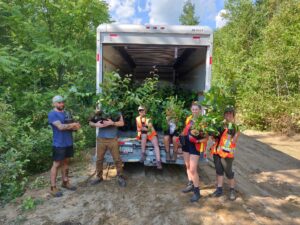In New Brunswick’s first-of-its-kind conservation easement, a deal struck to reforest Marysville Flats
Hadeel Ibrahim, CBC News

Before settlement, a swath of floodplain forest on Fredericton’s north side was ideal habitat for species now sparse or endangered – tall and reaching bur oaks and silver maple, soaring bald eagles and bank swallows.
Over the course of history, the area was clear cut for farming, destroying the wetland forest along the Nashwaak River. With no root systems to hold the soil together, flooding started washing it into the river.
The Nashwaak Watershed Association has been trying for 10 years to reverse this destruction, planting thousands of trees and hoping for the return of the eagles and wood turtles.
This year, the association was able to get a permanent protection for the land from the City of Fredericton, the first conservation easement granted by a municipality in the province, according to the group’s Marieka Chaplin.
- Young and old gather in Marysville to help the Nashwaak River
- Tree planting can reduce flood risk, say wildlife and watershed groups
The 23 acres (about nine hectares) of wetlands called Marysville Flats is not a hotbed for development, said Chaplin, the executive director of the Nashwaak Watershed Association, but the easement means peace of mind for conservationists.
“What this conservation means is it protects it in perpetuity,” she told Information Morning Fredericton.
“It’s also part of a larger view towards how we can steward land, and how we can better look after it and restore it.”
Chaplin said this particular area, near the former cotton mill on McGloin Street and adjacent to the Marysville Heritage Centre, is ecologically significant.
“There are many rare species that call it its home,” she said.

This includes bald eagles, bank swallows, which love the riverbanks on the Nashwaak, as well as the wood turtle.
Those animals love to coexist with particular types of trees, ones the association has been replanting in the area. They include silver maple trees, butternut, ash an native red-tipped willows. Those trees also prevent erosion and retain moisture.
“We’re also really keen to be planting bur oak, which is a species of special concern here in our province,” she said. “It’s one of those rare species that would have been much more part of the floodplain tree canopy before it was cleared.”
She said the trees planted with the help of volunteers have been thriving.
Property remains with the city
The property still belongs to the city. According to a report submitted to council, the city bought the land in 2009 because of its possible recreational value.
The easement, a fairly new concept made possible by New Brunswick legislation passed in 2011, “is a legal agreement that allows landowners to protect and preserve property through an agreement with a third-party agency while also maintaining ownership of the property,” the city report said.
“These rights run with the land in perpetuity unless certain conditions are not met (e.g. the third-party agency ceases to exist).”
Chaplin said volunteers and conservationists planted 14,000 trees this year and plan to plant more next year.
She said the association has its eyes on similar properties that could be protected using this new method: Neill’s Flats off Gibson Street.
“We’re also hoping to work with the city to eventually establish a conservation easement there, acknowledging…it is quite a bit of work on the part of the city to get that legal mechanism in place,” Chaplin said. “[We’re] very committed to restoring and re-wilding important parts of the watershed.”
Check out the story from CBC News here: Large swath of wetland on Fredericton’s north side is now permanently protected.

